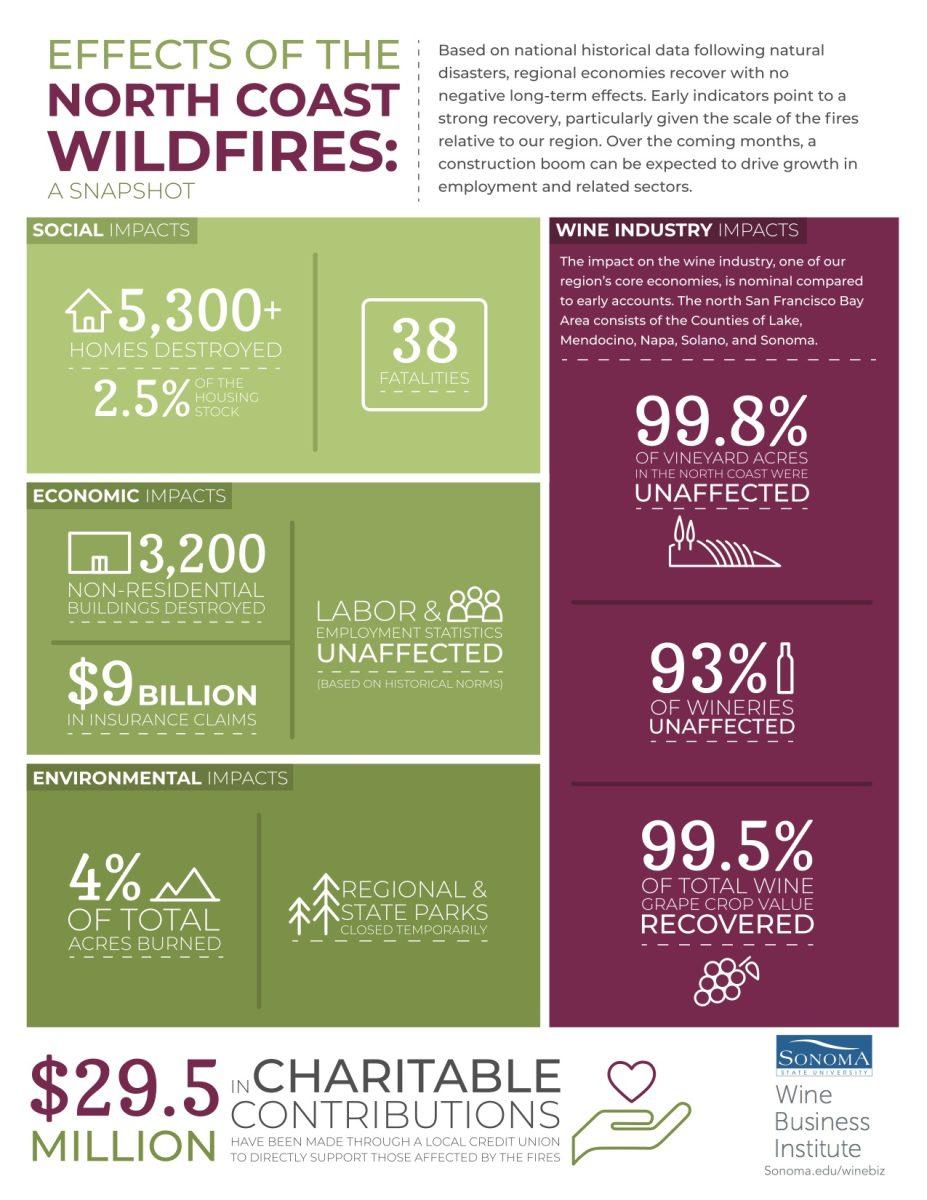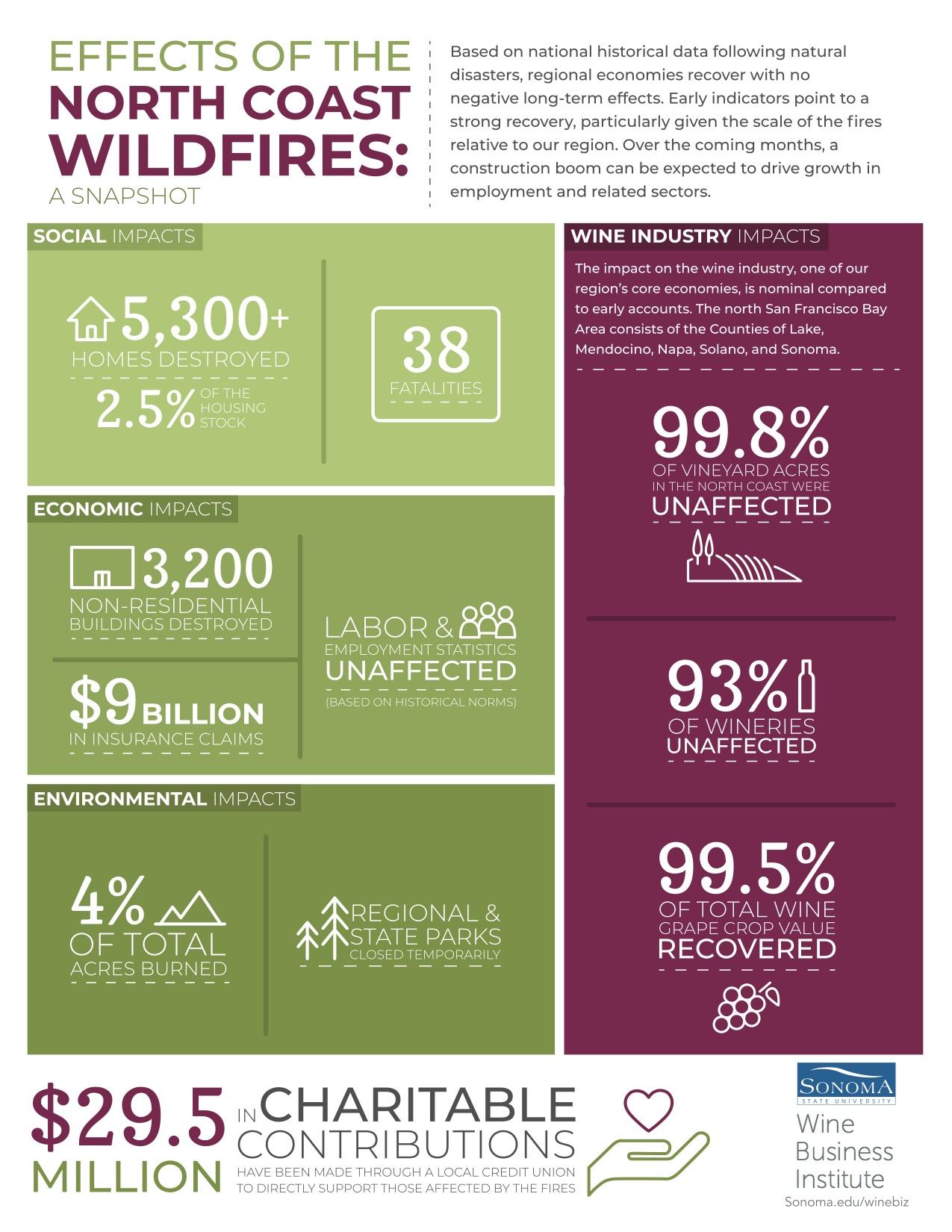After the smoke cleared, how big a mark the fires would leave on local vineyards concerned many in the wine industry.
The answer, according to an ongoing Sonoma State University study, is clear: not much.
A recent survey conducted by the Wine Business Institute at Sonoma State University has found that the October fires left 99.8 percent of the North Coast’s vineyards unaffected. The school based the study on a survey of more than 200 vineyard and winery stakeholders across Lake Mendocino, Napa, Solano and Sonoma counties, covering a total of 139,204 acres of vineyards. According to Honore Comfort, wine business executive in residence at Sonoma State, the Institute meant the survey to give stakeholders plans for recovery and revitalization via a “fact-based assessment of the true impact of the fires on the North Coast Wine Industry.”
As such a massive part of Sonoma County culture, wine dominates lifestyles, economies and acres of land in the North Bay. According to the study, 93 percent of wineries reported as unaffected by the fires, in terms of structural damage and long-term impact. In even more promising news, the study concludes wineries recovered 99.5 percent of the total crop value, when comparing numbers to 2016’s crop.
A common concern was that grapes can become stressed when in uncommon environmental situations. Many vintners were worried that consumers would conclude that 2017 wines had experienced smoke taint from grapes in the fire areas. But the study showed most of the grapes from 2017 had already been harvested by the time the fires hit.
However, while Comfort said grapes can’t become stressed, harsh growing conditions can affect the vines. In fact, Comfort said, “a certain amount of managed stress to the vine is a good thing, as it reduces yield and concentrates flavors in the grapes.”
An important factor in the study was that the fires occurred late in the grape’s growing season, which, according to Comfort, was actually a benefit. “The grapevines were… still full of water and green leaves. These acted as a natural fire-retardant so the fires rarely penetrated vineyards beyond the first three to four rows of grapevines,” Comfort said.
According to the study, in the affected areas, vineyards often served as firebreaks that prevented the spread of fire, which is considered a primary cause for the limited damage. In fact, 90 percent of affected wineries and grape growers reported that vineyards would not need to be replanted or replaced, and of those that do, most would be less than 10 acres.
While the public expected to see a greater physical impact on the grapes, the study noted more of a financial impact. According to the study, 71 percent of survey respondents experienced an immediate drop in tasting room traffic compared to the same period last year, but this trend started to recover in November. The unexpectedly large percentage of vineyards unaffected by the fires is helping the industry regain traction and is bringing tourism back to the area.
“The most significant impact on the North Coast wine industry was an immediate and temporary slow-down of visitors to the region,” Comfort said. The Sonoma County tourist industry believes it took a hit due to miscommunicated information, or according to Comfort, “early accounts of the fires led to inaccurate reports of damage to wineries and vineyards.”
With 75 percent of respondents noting online sales as equal to or higher than during this same period last year, the dip in economy and tourism is already beginning to correct itself. According to Comfort, moving forward, those at the Wine Business Institute “will apply these findings in a coordinated plan to ensure confidence among consumer, media and trade organizations in the quality standards for the 2017 vintage.”
The Wine Business Institute will continue to gather information further into 2018. With the Wine Spectator Learning Center grand opening scheduled for May, 29, 2018, the Wine Business Institute is expecting a busy year ahead.




































